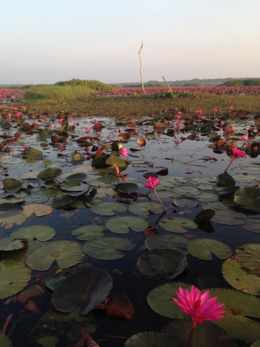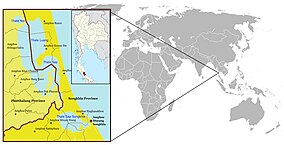Thale Noi Non-Hunting Area
| Thale Noi Non-Hunting Area | |
|---|---|
| Thale Noi Waterfowl Reserve | |
|
IUCN category III (natural monument or feature)
|
|

Thale Noi
|
|

Thale Noi Locator Map
|
|
| Location | Phatthalung Province, Thailand |
| Nearest city | Phatthalung |
| Coordinates | 7°46′00″N 100°09′11″E / 7.76667°N 100.15306°ECoordinates: 7°46′00″N 100°09′11″E / 7.76667°N 100.15306°E |
| Area | 460 km2 (180 sq mi) |
| Established | 29 April 1975 Ramsar Site 13 May 1998 |
| Governing body | Royal Forestry Department |
Thale Noi Non-Hunting Area (alternate spelling: Talae or Talay) is a protected fresh water wetland located in Phatthalung province, southern Thailand. Covering an area of 460 km², the wetlands are situated approximately 20 km inland from the east coast peninsula of the Gulf of Thailand and 115 km north of the Malaysian border in Satun province. Thale Noi Non-Hunting Area is one of the largest natural freshwater lakes in South East Asia. It is the smallest, northernmost basin in the chain of lagoons that form Songkhla Lake, spreading across three provincial boundaries into Nakhon Si Thammarat, Phatthalung and Songkhla provinces and is home to the critically endangered Irrawaddy dolphin (Orcaella brevirostris).
The Thai name ‘Thale Noi’ translates to ‘little sea’ in English language (thale = sea; noi = little). The wetlands were internationally recognised as a biodiversity hotspot in 1975 when the Department of National Parks, Wildlife & Flora, under the Ministry of National Resources and Environment and in conjunction with the International Union for Conservation of Nature (IUCN) declared it a Protected Area Category III (Natural Monuments), aimed at protecting particular natural features of a small area with high visitor value. The wetlands’ valuable feature is its provision of suitable breeding habitats for tens of thousands of native and migratory bird species. Thale Noi Non-Hunting Area was the first official non-hunting wildlife area declared in Thailand. Furthermore, the Kuan Ki Sian knoll, a 4.94 km² area within the non-hunting grounds was declared as a ‘Wetland of International Importance’ in 1998 by the Ramsar Convention for its diversity of flora and fauna species, its value as a breeding haven for myriad bird species and for the presence of vulnerable and endangered species inhabiting the area. The wetlands are presently governed by the Royal Forestry Department who work with local authorities and communities to manage the reserve.
Thale Noi Non-Hunting Area experiences tropical monsoonal weather with little variation in average temperatures throughout the year. There are distinct wet and dry seasons experienced on the southern east coast of Thailand with the rainy season running from October to March and dry season from April to September; November being the wettest month of the year and July being the driest.
Thale Noi Non-Hunting Area is part of the greater Songkhla Lake Basin, the largest lagoon lake in Thailand, covering an area of over 8,000 km2 (3,100 sq mi) in its entirety. There are over 38,000 people residing within the Thale Noi area with income predominantly sourced from fishing and sedge basketry production. The lake joins with Thale Luang, a 473 km2 (183 sq mi) basin, via 3 channels – Khlong Naang Riam, Khlong Ban Klang and Khlong Yuan, however sluice gates were installed in 1956 by the Royal Irrigation Department to prevent salt water intrusion to create freshwater conditions conducive to rice production (see Environmental Threats). Thale Luang adjoins Thale Sap (360 km2 or 140 sq mi) which connects to the southernmost lake, Thale Sap Songkhla (182 km2 or 70 sq mi) that opens into the Gulf of Thailand through a 380 m wide strait. Approximately 94% (422 km2 or 163 sq mi) of the reserve is terrestrial and 6% (28 km2 or 11 sq mi) is aquatic. Thale Noi lake is approximately 5 km wide and 6 km long with an average depth of 1.2 m, however water levels fluctuate significantly with changing seasonal conditions, dropping to around 80 cm in dry season and increasing to a depth of 3 m in some areas during the wet season.
...
Wikipedia
